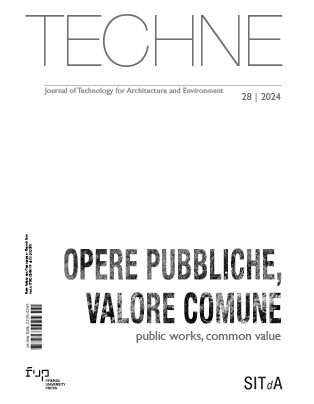Published 2024-10-29
Keywords
- Recovery,
- Cultural Heritage,
- Common goods,
- Circular regeneration model,
- Multidimensional evaluation framework
How to Cite
Copyright (c) 2024 Francesca Ciampa, Martina Bosone

This work is licensed under a Creative Commons Attribution 4.0 International License.
Abstract
Regenerating cultural heritage implies adopting a systemic and multi-scalar approach capable of considering the characteristics and flows of relations between the different components of the system. The regeneration project can be a circular strategy to reconnect people and places, generating and regenerating material and immaterial values of cultural heritage as a ‘common good’. The research proposes a circular and participatory regeneration model, validated through an evaluative framework. It supports decision-making and assesses the multidimensional impacts of reuse, redevelopment, maintenance and management practices of the commons, at all stages of the recovery project, and with respect to emerging instances and criteria adopted in existing policies.
Downloads
References
- Beauregard, R. (2015), “We Blame the Building! The Architecture of Distributed Responsibility”, International Journal of Urban and Regional Research, Vol. 39, n. 3, pp. 533-549. Available at: https://doi.org/10.1111/1468-2427.12232. DOI: https://doi.org/10.1111/1468-2427.12232
- Bosone, M. and Ciampa, F. (2021), “Human-Centred Indicators (HCI) to Regenerate Vulnerable Cultural Heritage and Landscape towards a Circular City: From the Bronx (NY) to Ercolano (IT)”, Sustainability, Vol. 13, n. 10, p. 5505. Available at: https://doi.org/10.3390/su13105505. DOI: https://doi.org/10.3390/su13105505
- Bosone, M. and Onesti, A. (2023), “The Role of Commons in Smart Sustainable Development: A Hybrid Approach for the Recovery of Settlement Systems”, in Lytras M.D., Housawi A.A. and Alsaywid B.S. (Eds.), Smart Cities and Digital Transformation: Empowering Communities, Limitless Innovation, Sustainable Development and the Next Generation, Emerald Publishing Limited, pp. 187-218. Available at: https://doi.org/10.1108/978-1-80455-994-920231010. DOI: https://doi.org/10.1108/978-1-80455-994-920231010
- Checkland, P.B. (1989), “Soft Systems Methodology”, Human Systems Management, Vol. 8, n. 4, pp. 273-289. Available at: https://doi.org/10.3233/HSM-1989-8405. DOI: https://doi.org/10.3233/HSM-1989-8405
- Ciampa, F. and Bosone, M. (2022), “Towards eco-social transition: Community Regeneration Indicators respond to the polycrisis | Verso la transizione eco-sociale: i Community Regeneration Indicators rispondono alla policrisi”, TECHNE – Journal of Technology for Architecture and Environment, Vol. 23, pp. 200–210. Available at: https://doi.org/10.36253/techne-12140. DOI: https://doi.org/10.36253/techne-12140
- Ciribini, G. (1984), Tecnologia e progetto, Celid, Torino.
- Council of Europe (2005), Framework Convention on the Value of Cultural Heritage for Society, Council of Europe Treaty Series, Council of Europe Treaty Series – No. 199, Faro, 27/10/2005. Available at: https://rm.coe.int/1680083746 (Accessed on 10/06/2024).
- Council of Europe (2018), Faro Convention Action Plan Handbook 2018-2019. Available at: https://rm.coe.int/faro-convention-action-plan-handbook-2018-2019/168079029c (Accessed on 10/06/2024).
- Ellen MacArthur Foundation (2015), Growth within: a circular economy vision for a competitive europe, Ellen MacArthur Foundation. Available at: https://emf.thirdlight.com (Accessed on 10/06/2024).
- European Commission (2024), Empowering Citizens in Shaping Europe’s Energy Future, Directorate-General for Communication, European Commission, Bruxelles/Brussel, Belgium. Available at: https://citizens.ec.europa.eu (Accessed on 10/06/2024).
- European Parliament (2015), Towards an integrated approach to cultural heritage for Europe, Report – A8-0207/2015, Committee on Culture and Education, European Parliament. Available at: https://www.europarl.europa.eu/doceo/document/A-8-2015-0207_EN.html (Accessed on 10/06/2024).
- Fusco Girard, L. (2013), “Creative cities: the challenge of ‘humanization’ in the city development”, BDC – Bollettino del Centro Calza Bini, Vol. 13, n. 1, pp. 9-33. Available at: https://doi.org/https://doi.org/10.6092/2284-4732/2448 (Accessed on 10/06/2024).
- Wijesuriya G. (2018), “Living Heritage”, ICCROM Sharing Conservation Decisions. Available at: https://www.academia.edu/39407212/Living_Heritage (Accessed on 10/06/2024).
- Gravagnuolo, A. et al. (2023), “Circularity assessment through ex-post evaluation of ‘best practices’: a modelling-based approach”, in Fusco Girard L. and Gravagnuolo A. (Eds.), CLIC Circular Models for Cultural Heritage Adaptive Reuse, Springer.
- ICOMOS (2017), Delhi Declaration on heritage and democracy, 19th General Assembly of the International ICOMOS, Delhi, India. Available at: https://www.icomos.org/images/DOCUMENTS/Charters/GA2017_Delhi-Declaration_20180117_EN.pdf (Accessed on 10/06/2024).
- Labsus (2021), Rapporto Labsus 2021. Available at: https://www.labsus.org/rapporto-labsus-2021/ (Accessed on 10/06/2024).
- Magli, V. (2018), La Forma della Città. Presentazione di uno strumento di valutazione in itinere del processo rigenerativo dell’Asilo Filangieri a Napoli, Tesi di Master Universitario “Rigenerazione Urbana e Innovazione Sociale”, Università IUAV di Venezia, 2017/18. Available at: https://www.glocalimpactnetwork.com/wp-content/uploads/2020/06/Magli_La_forma_delle_città.pdf (Accessed on 10/06/2024).
- Pinto, M.R. and Viola, S. (2015), “Identità sedimentate e nuova prosperità per il paesaggio urbano produttivo”, BDC-Bollettino del Centro Calza Bini, Vol. 15, n. 1, pp. 71-91.
- Resilience 21 Coalition (2021), Resilience21 building a nation of resilient communities. Available at: https://www.resilience21.org/home (Accessed on 10/06/2024).
- Sinopoli, N. (1997), La tecnologia invisibile, Franco Angeli, Milano, Italia.
- UNESCO (2011), Recommendation on Historic Urban landscape, United Nations Educational, Scientific and Cultural Organization, Paris, France. Available at: http://whc.unesco.org/document/172639 (Accessed on 10/06/2024).
- United Nations (1948), The Universal Declaration of Human Rights, United Nations, Paris. Available at: https://www.ohchr.org/en/universal-declaration-of-human-rights (Accessed on 10/06/2024).
- United Nations (2015), Transforming our World: the 2030 Agenda for Sustainable Development, A/RES/70/1, Resolution adopted by the General Assembly on 25 September 2015, United Nations, New York, NY, USA. Available at: https://documents.un.org (Accessed on 10/06/2024).
- Zamagni, S., Venturi, P. and Rago, S. (2018), “Valutare l’impatto sociale. La questione della misurazione nelle imprese sociali”, Impresa Sociale, Vol. 12. Available at: https://www.rivistaimpresasociale.it/rivista/articolo/valutare-l-impatto-sociale-la-questione-della-misurazione-12 (Accessed on 10/06/2024).






